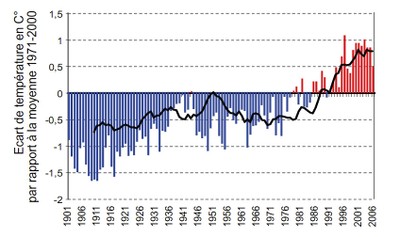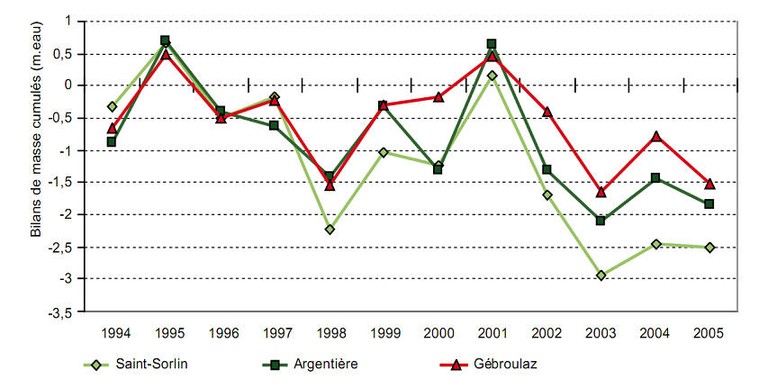Published: 26 Nov 2010
Modified: 17 Feb 2025
Temperature change in France
In France as in the rest of the world, the last
decade has seen a systematic increase in the mean temperature for 1971-2000,
and seven of the ten hottest years since 1901. According to Météo-France, the
average increase in temperatures in France during the twentieth century is around
0.9°C. The warming is more pronounced in the south than in the north of the country.
Minimum temperatures have also increased more (from 0.9 to 1.5 C) than
maximum ones (from 0.3 to 1.1°C).

|
Ecart de
température en C° par rapport à la moyenne 1971-2000
|
Deviation
in temperature in °C in relation to the 1971‑2000 mean
|
Example of impact: the retreat of the Alpine glaciers
The Alpine region has
proved to be particularly sensitive to global warming. Like many mountain
areas, the Alps are home to a wide variety of flora and fauna and numerous
protected species that are especially sensitive to variations in climate. The Alps
are also seen as Europe’s water tower, feeding several major European rivers, thanks
to their mantle and glaciers. The regression of these glaciers should lead to a
reconsideration of how water resources are managed in the Alpine region.

|
Évolution
des bilans de masse cumulée de 3 glaciers des Alpes françaises depuis 1994
|
Cumulative
change in the mass balances of three glaciers in the French Alps since 1994
|
|
Bilans de
masse cumulés (m.eau)
|
Cumulative mass
balances (m. water)
|
The reduction in the mass of the Alpine glaciers
has not been uniform over time. The sharp drops (as a consequence of winters
with little snow and hot summers) has been interspersed with short periods of
growth.
Example of impact: changes in numbers of birds over-wintering in France
The greylag goose (Anser anser) is over-wintering in
increasing numbers at protected sites in France. European populations of
nesting birds also increased significantly in the period 1990-2000. Although the
monitoring of protected sites has undoubtedly improved and the number of birds has
increased, one of the other explanations put forward is that this is due to
climate change which enables the birds to overwinter, no longer only in
southern Europe, but also at higher latitudes, and notably in France. The consequent
reduction in migratory journeys would then have a positive effect on the reproduction
of these species. This increase in over-wintering began at the end of the 1980s,
at which time a significant increase in mean annual (and in particular winter) temperatures
was noted in France. The rise in the population accelerated sharply towards the
middle of the 1990s.

Change
in the numbers of greylag geese in France over-wintering in protected sites
Sources:
Bird Protection League (Ligue de Protection des Oiseaux, LPO); Wetlands
International; Ifen, ONERC.



Document Actions
Share with others